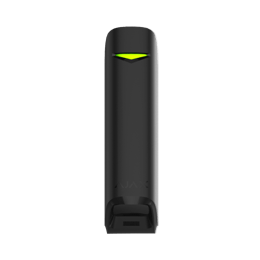Ajax MotionProtect Curtain: the history of the development of the pet-friendly indoor/outdoor curtain detector
- , by AlarmsysteemExpert
- 14 min read

Ajax MotionProtect Curtain: the history of the development of the pet-friendly indoor/outdoor curtain detector.
Ajax MotionProtect Curtain: the history of the development of the pet-friendly indoor/outdoor curtain detector.

The security system should detect threats as early as possible - this is a fundamental security rule. If you have an outdoor area around your home, outdoor detectors should be installed there. To detect an intruder before opening a door or breaking a window, it must activate the sirens and give a lead to the security company or police crew on duty. This significantly increases the chances of preventing harm and protecting people's health and lives.
The protection of a territory can be implemented in two ways. If the house is fenced and outsiders are not allowed to enter, motion detectors with a wide horizontal viewing angle and detection range are used. This was precisely the device Ajax used to launch its range of outdoor security devices: MotionProtect Outdoor . Otherwise, in cases where the detection zone must be restricted, curtain detectors are used. They detect motion in a narrow area so no one can approach a door or window, enter a terrace or climb onto a balcony undetected. They use an invisible curtain to shield the area where people can move freely.

Wireless Ajax MotionProtect Curtain Movement Detector
In March 2019, we presented Ajax's first curtain motion detector - MotionProtect Curtain . In this article, we will talk about everything that had preceded the release: the decision on the capabilities of the new product; the reasons for the development of two unique optical systems; the capabilities of the ZOE algorithm; and prototyping and testing that ensure the highest accuracy of human detection.
An uncompromising "curtain"
Customers and partners from Italy, Spain, Portugal, France and other countries of southwestern Europe initiated the release of the new device. In these countries, panoramic windows and terraces that can be used to secretly break in are very popular. To reduce the risk of burglary, the exterior of a building is protected with small-angle motion detectors. In addition, "curtains" protect valuables in buildings: safes, document vaults and works of art. We used these application scenarios as our springboard.
Before we began developing the MotionProtect curtain, we conducted extensive market research: the technologies and capabilities of leading market players; the expectations of security professionals and users; the areas where a technological or functional breakthrough can be made.
We found that the best representatives of this class of detectors were equipped with anti-masking systems and that some of them could operate with batteries for long periods of time. But in terms of range and reliability of communication, no device could compete with Ajax devices. Most curtain detectors were unable to distinguish a pet from a person and could at best ignore natural interferences: heated air currents, swaying leaves, etc. Only one manufacturer offered detectors that were immune to animals.
That was a challenge! Our MotionProtect Curtain Curtain Detector must identify people 100% accurately and prevent them from responding to interference and reduce animal reactions as much as possible - no matter the conditions on the premises, you must be able to rely on the alerts. Effective identification of masking when the risk of sabotage outside is high. Work together for years on bundled batteries and always maintain a connection - Ajax customers are used to the reliability and ease of maintenance of our equipment. Meanwhile, it should be compact and have a great design that looks nice both outside and inside.
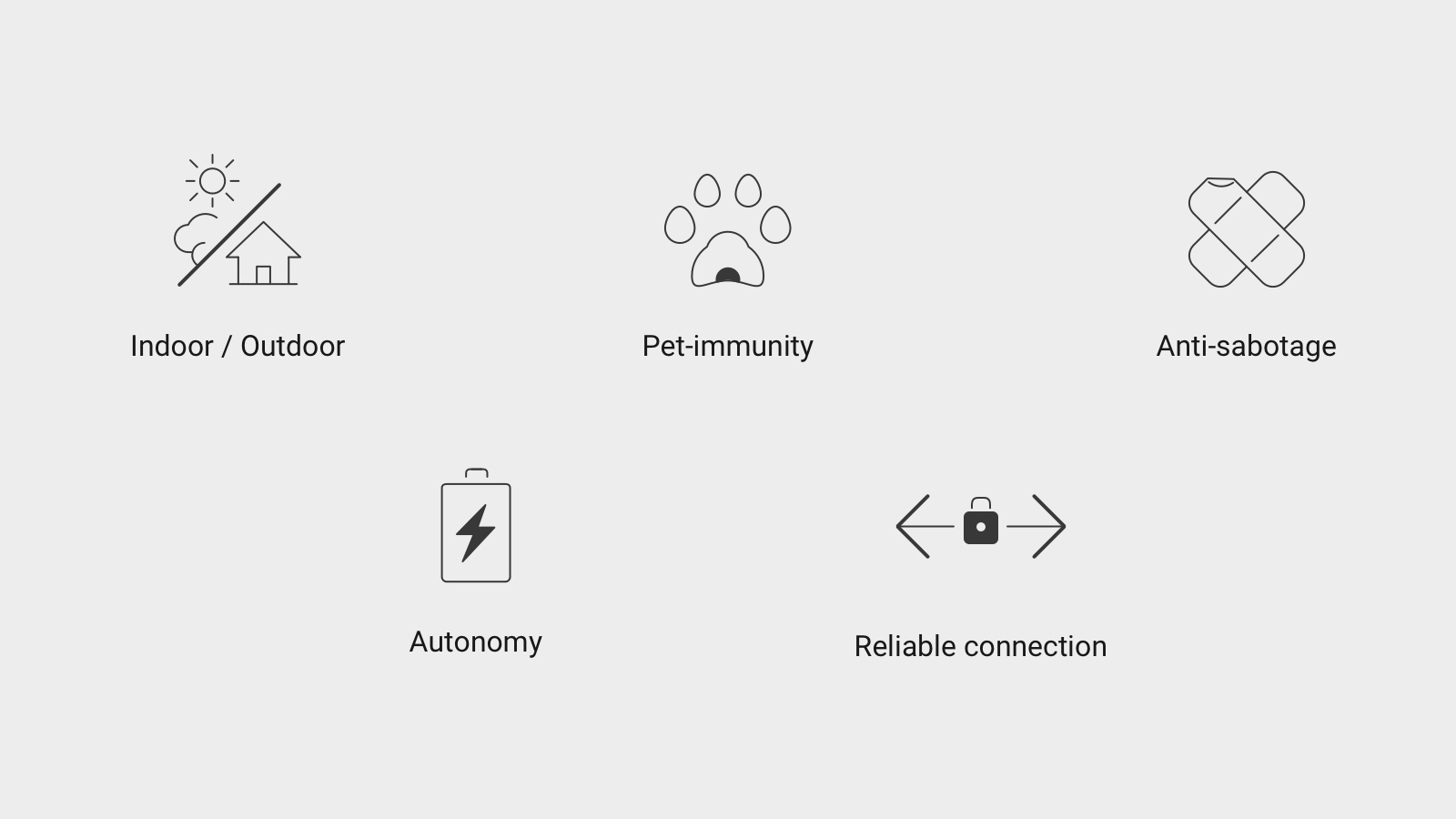
A unique motion detection system
Motion detection system is the most important element of curtain detector. The simplest detectors use only a single PIR sensor and an optical focusing element: a mirror or Fresnel lens. More expensive models are equipped with an additional microwave sensor to filter out natural interferences.
| Every hot object emits infrared radiation. A lens or mirror focuses this radiation on a specific area of the pyroelectric detection element (PIR sensor). When the object moves, the radiation it emits hits different areas of the sensor and also changes its intensity. By analyzing this data, the detector determines whether it is: a threat or a false alarm. |
|---|
We began development by testing the capabilities of these technical solutions. Using the components of Ajax motion detectors MotionProtect and MotionProtect Plus, we have assembled test benches. Without the bodies or connection to the hub - only the most essential hardware to gather information about the events occurring in a small field of view. In the laboratory, we simulated everything a curtain detector might encounter at the actual location: warm air currents, moving animals, birds, bushes and grass swaying in the wind, normal (and even strange) human behavior. We then examined what triggered our test banks and how they "saw" these events. The results of a single PIR were deplorable. A system consisting of a single PIR sensor and microwave sensors with a horizontal viewing angle of 6° can provide maximum protection against natural interference, but may not differ from person to animal.
Our "curtain" needed to be able to receive more information about events in the detection zone. Therefore, we adopted the approach used in the motion detector Outdoor MotionProtect Outdoor : the system consisting of two PIR sensors. Only they were not narrow multi-directional "beams" but rather discrete "fan-shaped" zones:

After assembling new test benches, the developers simulated the behavior of humans, animals, birds and a variety of natural disturbances in the laboratory. They changed the ambient temperature, studied the effect of speed and direction of movement, and then analyzed the data collected by the sensors. The results were promising! We now had a prototype optical system with which to develop pet immunity.
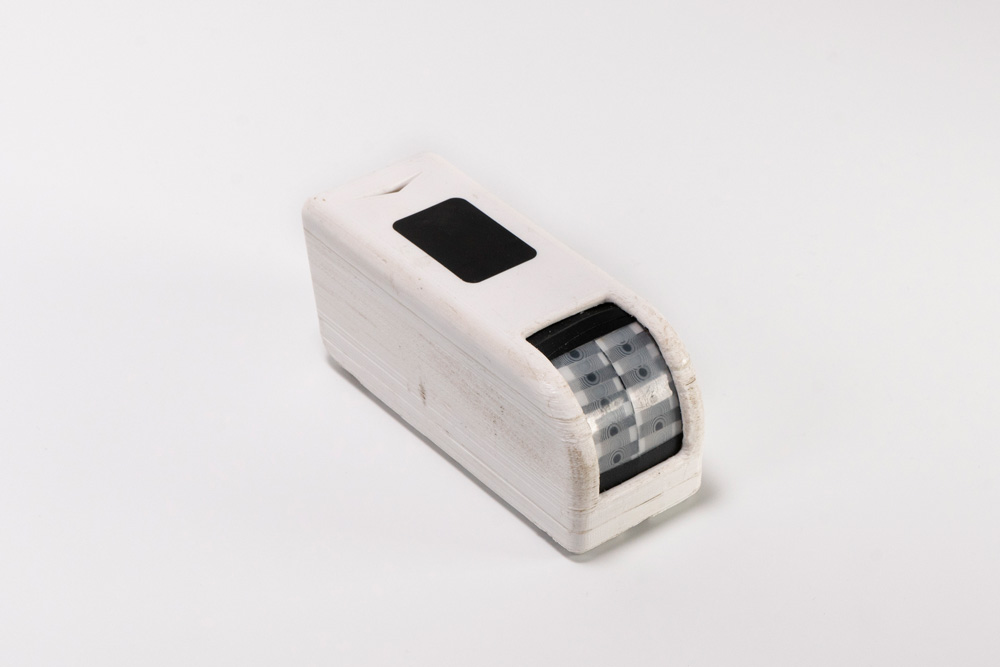
Ajax MotionProtect Curtain early prototype
But it was impossible to buy components for it. While curtain detector optical systems based on PIR and microwave sensors were commercially available, paired Fresnel lenses that projected infrared radiation onto two PIR sensors simultaneously were not commercially available. To develop the curtain detector we came up with, we had to create a new optical element, and that also meant establishing its production.
We solved this daunting task through the R &D department of Ajax Systems. If we had hired a contractor, the project would have been suspended for several months. Because it was important for the device to be compact, we chose a focusing mirror. We calculated the number, area and direction of the 10 planes placed on two panels - one for each PIR sensor. We had to walk the entire path from the design of optical elements using specialized software and perfectly polished metal models to batch production of parts with a special reflective coating. We then built test benches using the new optical elements and tested the system in action: on people, animals and disturbances typically found outside and inside buildings.
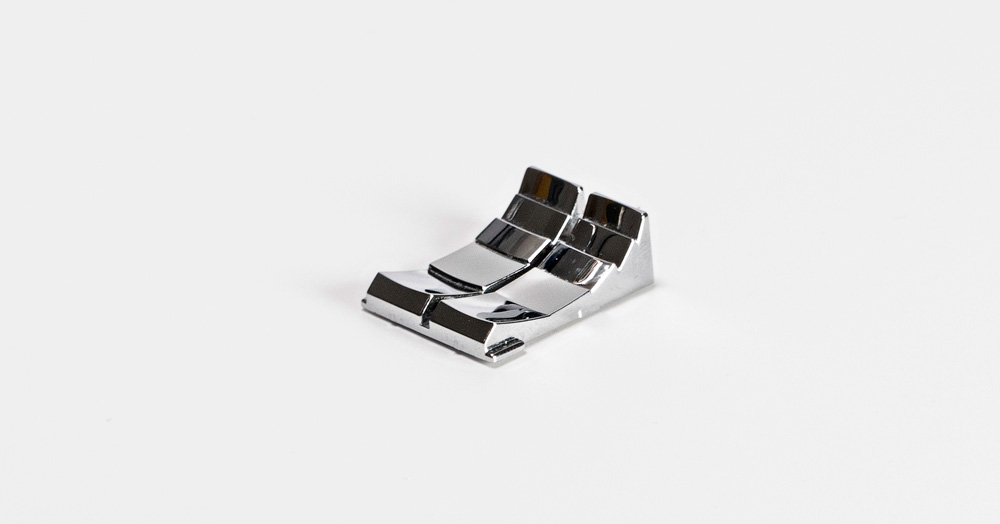
Segmented mirror of the MotionProtect curtain detector
Four months after developing the new detector, we had a suitable optical system. It offered a horizontal viewing angle of 6° and could detect motion at a distance of 11 meters. And most importantly, it collected enough data to distinguish a human from a pet or a bird and minimize the chance of false alarms caused by natural events.
Professional protection against sabotage
In addition to developing the motion detection system, we were also working on countering masking. This is a typical sabotage tactic used with outdoor security systems: block the view of motion detectors (by covering or painting the lens) when the system is inactive and then break into the secure premises undetected. Our curtain detector needed to be able to detect such threats. The small size of the body and power consumption limitations did not allow for multiple IR emitters and mask sensors (there are three in MotionProtect Outdoor), so we had to think outside the box again.
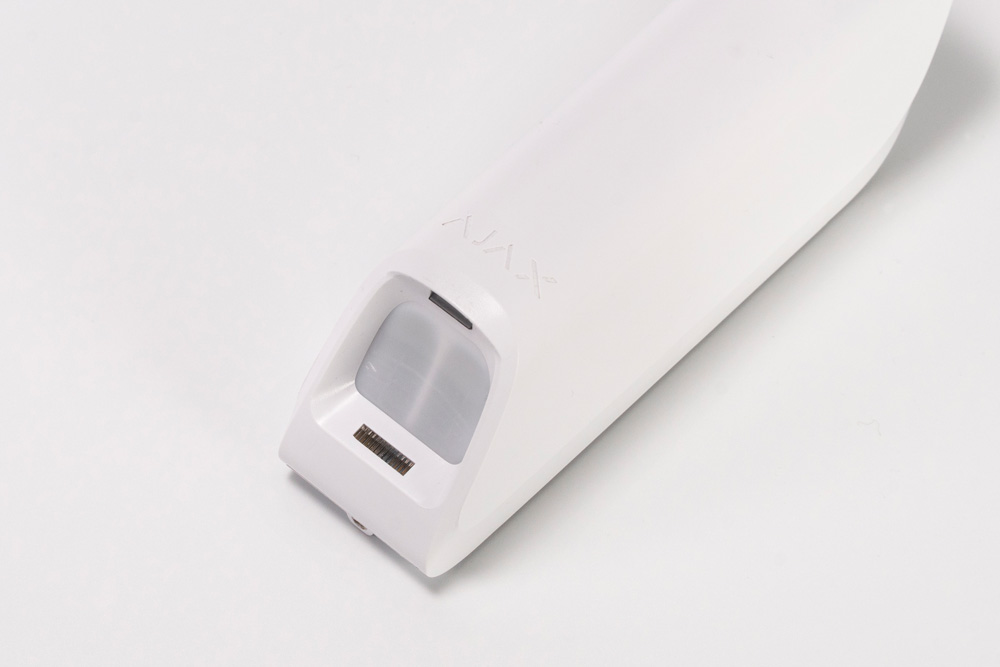
For the curtain detector MotionProtect Curtain, another unique optical system has been developed that separates infrared radiation from a single source into two streams: one detects the emergence of an object in front of the detector (cover) while the second detects the painting of the body with a transparent varnish. In this way, continuous detection of masking consumes very little electrical power without having a significant effect on the autonomous operating time of the device.
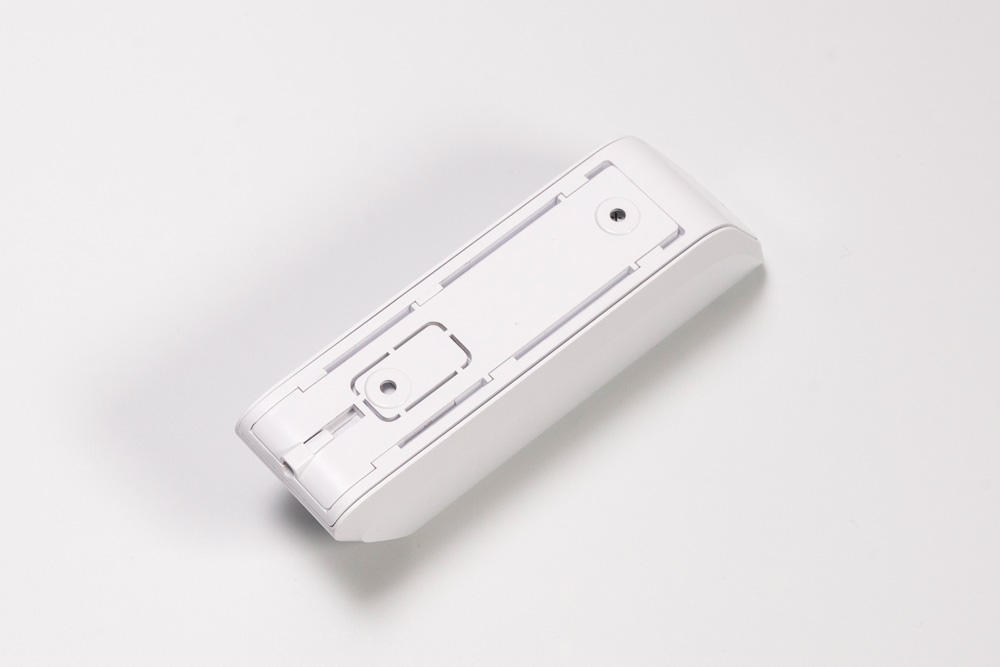
The sabotage unit does not allow a deactivated detector to be secretly dismantled
The detector was also equipped with two tamper units: the first responded to the opening of the body and the second responded to attempts to detach the unit from the SmartBracket mounting panel.
Combined with frequent polling of the detector by the hub that can identify loss of communication with the device in less than a minute, these systems provide 100% protection against tampering.
From test bench to detector
The next generation of prototypes can already be called Ajax detectors. Still without a body, but it already had optical and anti-masking systems, a processor, memory and radio communication module, firmware and the ability to work as part of a security system. This stage of development involved several parallel processes. The engineers worked to determine the optimal configuration of the internal components, changed the circuit boards and thought about the manufacturing and assembly process. The body is developed - the internal design and the exterior.
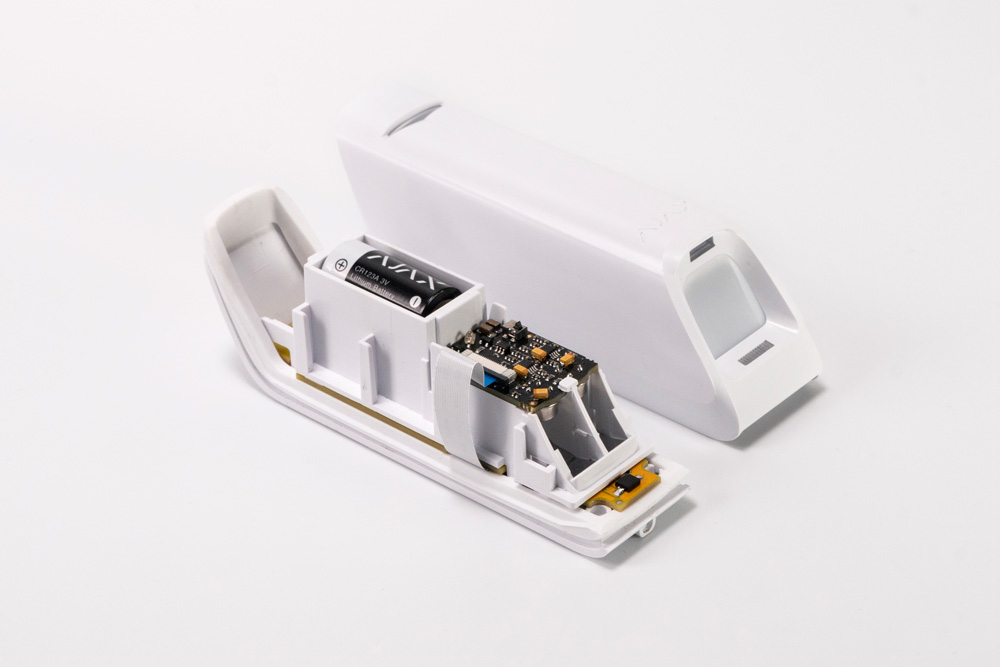
MotionProtect Curtain components are placed on two circuit boards connected by a loop
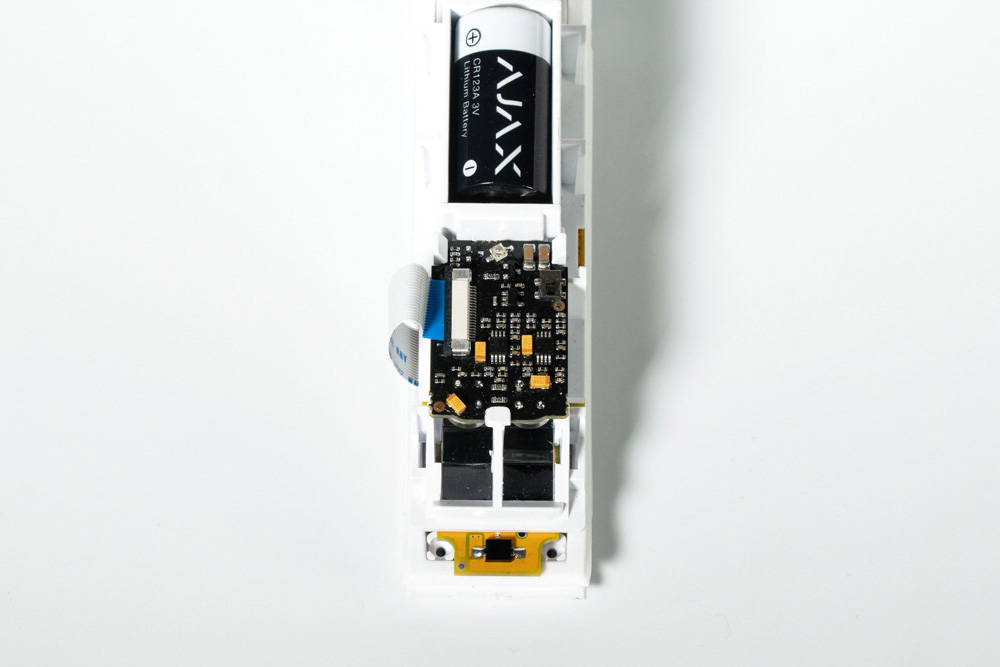
MotionProtect Curtain uses a four-layer circuit board with an integrated Jeweler antenna
Ten months into development, we had functional detectors in 3D printed bodies that looked as close as possible to the final product in terms of hardware. We were now certain that the design was suitable for large-scale batch production, and we could now begin developing a new algorithm for signal analysis.
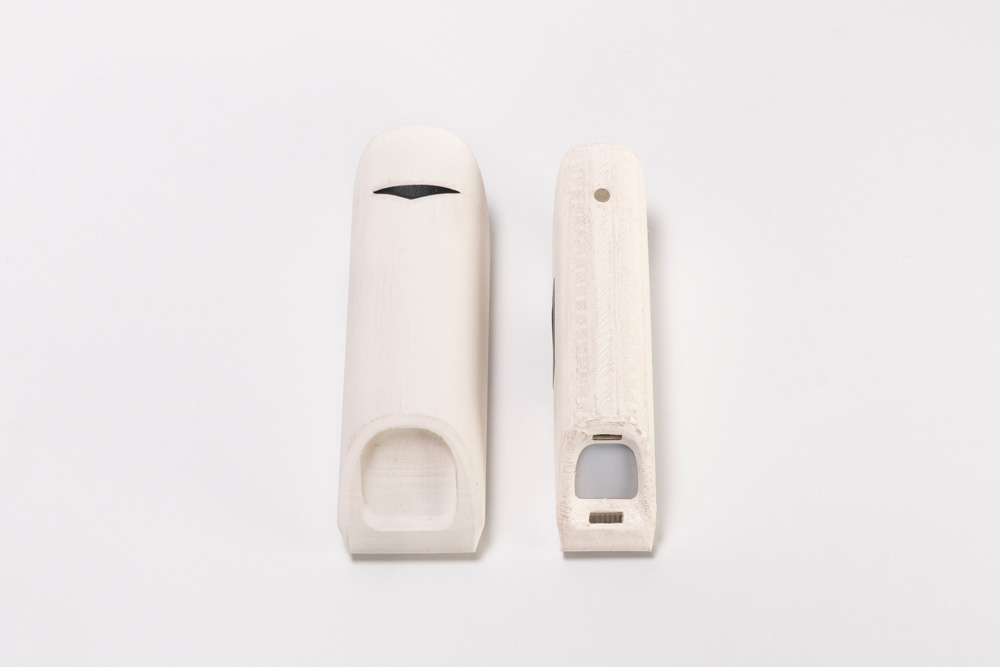
MotionProtect Curtain prototype and already working device in body printed on a 3D printer
ZOE-algoritme
The basis for developing the new software was the SmartDetect and LISA algorithms used in Ajax's indoor and outdoor motion detectors, as well as the understanding of how MotionProtect Curtain's optical system "sees" people, animals, birds and natural interferences. We collected 30 identical detectors and installed firmware with a draft version of the ZOE algorithm so that the devices could make their own decisions regarding which signal could be considered an alarm to be sent to the hub and which signal should be ignored as interference. And we equipped them with special "black boxes" that retain all the original data in the detector memory when activated.
The prototype detectors were tested in real buildings in Ukraine, Italy, Spain, Greece and Cyprus: urban and suburban land plots, apartments, houses and offices with the worst conditions the curtain detectors could encounter. When the sun blinds the lens, the body is filled with rain, trees, bushes and tall grass appear in the field of view, and animals of various sizes continuously trigger false alarms. Since the summer, the R & D team has moved several days into a giant industrial cold house with a temperature of -20°C to test the operation of the device under extreme conditions.
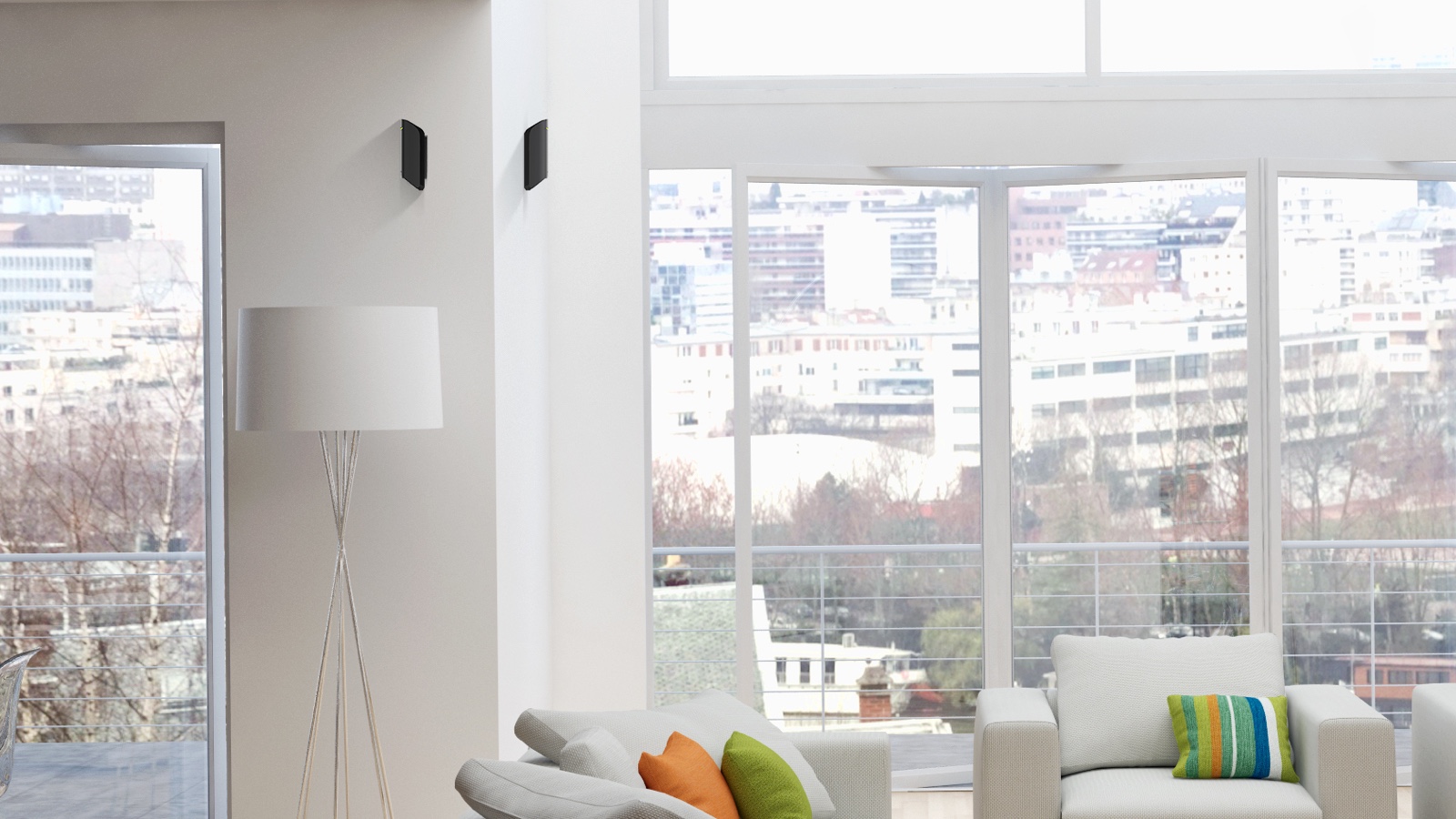
MotionProtect curtain in a black casing (for indoor use only)
In the course of a month, we perfected ZOE: we received false alarms, compared the data from the "black boxes" with detection conditions, made corrections to the code and updated the software of the test devices. Each new version of the algorithm reduced the number of false alarms until we achieved absolute accuracy in human detection and effective filtering of interferences.
How ZOE works
The MotionProtect Curtain Curtain Detector's motion detection system offers two modes: with active pet immunity and without.
When pet immunity is enabled, PIR sensors represent independent data sources. Once in the detection zone, a person passes two solar emitters that generate signals from two sensors with the characteristic symmetry and coverage. The ZOE algorithm immediately analyzes the data by comparing the parameters of the signals and making a judgment: intrusion. Animals, glances, leaves fluttering in the wind, air currents trigger signals of various kinds, and the MotionProtect curtain ignores them as false alarms. In this mode, the curtain detector can operate outdoors.
Fourteen months after its development, the second street motion detector, MotionProtect Curtain, appeared in the Ajax range. With ultra-precise detection of people, effective immunity to animals and protection against false alarms. Indoor and outdoor use and with anti-masking capabilities. With reliable and safe jewelry technology and excellent autonomy. Can be configured remotely via the app. Ready to secure an apartment, detached house and commercial or manufacturing facilities.

bestek
| Sensorelement | Twee PIR-sensoren |
|---|---|
| Detection angle | Horizontal - 6 ° vertical - 90 ° |
| Motion detection distance | Up to 11/10/9 m (with pet immunity enabled - up to 6/5/3 m) depending on sensitivity settings |
| Gevoeligheid | Adjustable, 3 levels |
| Pet immunity | Weight - less than 15 kg, height - less than 40 cm |
| Anti-sabotage | 24/7 anti-masking Fraudebeveiliging Storingmelding Sabotagebestendig |
| Communicatie bereik | Up to 1700 m in open areas |
| Batterijduur | Up to 3 years |
| Operating temperature range | From -25°C to +60°C |
| Humidity control | Up to 95% |
| Beschermingsklasse | IP54 |
| Dimensies | 134 х 44 х 34 mm |
| Gewicht | 118 g |
| verenigbaarheid | Works only with Hub and Hub Plus |
Consult the user manual of the device for more information.

